Komentáře / Otázky (31)
![]() Janna napsala:
Janna napsala:
Hallo, danke für die tolle Anleitung! Ich bin am Hals angekommen, verstehe aber nicht, wie ich die 23-27 Maschen aus den stillgelegten und den abgeketteten Maschen am vorderen Halsausschnitt aufnehme. Es sind ja viel mehr Maschen stillgelegt und auf dem Hilfsfaden und ich weiß nicht, wo ich einstechen muss. Das Video unter der Anleitung hilft mir hier leider auch nicht weiter. Danke für die Hilfe! :)
27.01.2024 - 21:55Odpověď DROPS Design :
Liebe Janna, diese 23-27 Maschen werden beim Vorderteil aufgefassen: es wurden 13-15 Maschen für den Halsauschnitt, Vorderteil stilgelegt + 2 Maschen 1 x + 1 Masche 2-3 Mal beidseitig abgekettet, dazu kommen die restlichen Maschen der Passe, so haben Sie ca 68 bis 84 Maschen. Viel Spaß beim stricken!
29.01.2024 - 12:01
![]() Bertha napsala:
Bertha napsala:
Ik brei kindertrui William, LI 002 by op een rondbreinaald. Voor de raglan moet je eerst om de naald minderen, en dan nog een paar keer elke naald. Als de steken voor de hals op een hulpdraad staan, moet je daardoor heen en weer op de naald, maar tevens elke naald minderen. Betekent dat dat je ook op de averechte naald moet minderen? Hoe dan? Als ik dezelfde mindermethode toepas op de averechte toer, staan de V tjes niet meer mooi de goede kant op.
05.02.2023 - 16:10Odpověď DROPS Design :
Dag Bertha,
In een van de bijgevoegde video's wordt uitgelegd hoe je de raglanminderingen aan de goede en de verkeerde kant maakt.
08.02.2023 - 11:36
![]() Manon napsala:
Manon napsala:
Je ne comprends la reprise des mailles encolure (sans bouton). Il faut relever de 23 à 27 sur le devant, mais dans la même phrase vous parler de 68 à 84, de quelles mailles s'agit-il ? et que signifie "dans le même tour répartir des diminutions/augmentations pour ajuster. Pour ajuster quoi ? puisque qu'on connait le nombre de mailles après les diminutions du raglan et du col. Merci de préciser s'il vous plait.
21.10.2022 - 11:48Odpověď DROPS Design :
Bonjour Manon, vous devez rabattre pour l'encolure les 13-15 m + de chaque côté: 1 x 2 m + 2 ou 3 x 1 m - pour le col, vous reprenez les 41 à 53 mailles qui restaient à la fin de l'empiècement et vous relevez en plus 23 à 27 mailles le long de l'encolure devant (les mailles en attente + les mailles rabattues) - vous devriez avoir 68 à 84 mailles; tricotez ensuite 1 tour jersey en ajustant le nombre de mailles à 64-76 (il doit être divisible par 4 = diminuez ou augmenter des mailles en fonction de celui que vous avez relevé). Bon tricot!
21.10.2022 - 16:09
![]() Johanna Smit napsala:
Johanna Smit napsala:
Ik wil een baby truitje breien met patentst op 2 naalden 4,5 voor 9 mnd maar kan gaan patroonvinden
16.10.2021 - 12:49Odpověď DROPS Design :
Dag Johanna,
Misschien dat dit patroon wat is? Deze wordt echter wel op de rondbreinaald gebreid van boven naar beneden.
Mocht je nog een ander patroon vinden die verder aan je wensen voldoet, maar op de rondbreinaald wordt gebreid dan kun je deze instructie raadplegen om het patroon aan te passen om met rechte naalden te breien. Helaas is dit niet voor ieder patroon geschikt.
17.10.2021 - 18:32
![]() Tina Hald napsala:
Tina Hald napsala:
Hej Jeg strikker sweateren uden knap kan . Der står man skal sætte 15 masker på en tråd , så vidt så godt . Men hvordan kommer man så videre ? Ret naturligt ville jeg så begynde at stikke frem og tilbage ( man kan jo ikke bare hoppe over 15 masker ? ) . Men det står der kun i opskriften med knap man skal gøre . Så synes det er lidt misvisende . Men jeg har altså strikket frem og tilbage idet jeg ikke kunne se andre løsninger
12.12.2020 - 17:19Odpověď DROPS Design :
Hei Tine. Om man har valgt å strikke med knapp må man strikke frem og tilbake når man begynner på bærestykket, Men skal man strikke uten knapp strikker man rundt til der man setter masker på en tråd til hals og deretter må man strikke frem og tilbake et lite stykke. Så du har gjort det riktig. God Fornøyelse!
16.12.2020 - 14:38
![]() Vera Myhrman napsala:
Vera Myhrman napsala:
Hej vilket annat garn kan jag ersätta Lima med? Konvertera hänvisar mig att skriva till er. Tacksam för hjälp Mvh Vera
15.08.2020 - 16:49Odpověď DROPS Design :
Hej Vera. Du kan ersätta Lima med ett annat garn ur garngrupp B. Du hittar en översikt över vilka garn som tillhör vilken garngrupp här. Tänk som vanligt bara på att få den stickfasthet som uppges i mönstret och att beräkna riktig garnåtgång med det alternativa garnet. Mvh DROPS Design
17.08.2020 - 10:52
![]() Johanna napsala:
Johanna napsala:
Hej! Jag stickar tröjan utan knappar i strl 12/18 mån. Jag blir förvirrad när det ska maskas av mot halsen. I beskrivningen står ”sedan maskas av mot halsen....” vilket jag tolkar som att det görs EFTER minskningar till raglan (eftersom det annars står ”samtidigt”). Men i svar på frågor skriver ni att det ska göras samtidigt med minskningar för raglan? Vad stämmer? Undrar också om det är sammanlagt 8 maskor som ska avmaskas till halsen? Tack!
12.12.2019 - 10:02Odpověď DROPS Design :
Hej Johanna, du minskar till raglan och samtidigt när arb mäter 29 cm sätts de mittersta 13 m fram på 1 tråd till hals, nu minskar du även till halsen i början på varje varv enligt beskrivningen. Lycka till :)
16.12.2019 - 15:32
![]() Winnie Normann napsala:
Winnie Normann napsala:
Jeg strikker den største str. uden knapper og er kommet dertil hvor jeg skal sætte masker til hals på en snor, jeg kan ikke rigtig hitte ud af om hvorvidt, jeg så efterfølgende, skal strikke frem og tilbage på rundpinden, for at kunne lave indt. til hals og så også lave raglan indt. på vrang pinden,eller kan det gøres fra retsiden, i givet fald hvordan? ;-)
18.02.2019 - 16:18Odpověď DROPS Design :
Hei Winnie. Når du har satt maskene på en snor strikker du frem og tilbake fra den ene siden av halsen til den andre siden av halsen, snu og strikk tilbake fra vrangsiden. Du feller av de ytterste maskene (altså nærmest halsen) på begynnelsen av hver 2 pinne som forklart. Dette gjøres samtidig som fellingen til raglan pågår, og du må felle til raglan fra vrangsiden når det skal felles på hver pinne. Før merke: ta 1 maske løst av som om den skulle strikkes vrang, 1 vrang, løft den løse masken over. Etter merke: strikk 2 vrang sammen. God fornøyelse
21.02.2019 - 14:12
![]() Malika napsala:
Malika napsala:
Ich habe die Arbeit genau nach Anleitung gestrickt in der Größe 2 Jahre. Eigentlich stricke ich eher eng. Trotzdem ist der Pullover relativ breit/weit geworden. Das ist bei Wollsachen, die ja sowieso die Tendenz haben, mit der Zeit noch etwas weiter zu werden, schade. Außerdem fand ich die Erklärungen für die Passe mit Knöpfen sehr unpräzise.
16.01.2019 - 15:10
![]() Malika napsala:
Malika napsala:
Und ergänzend dazu: wie viele Reihen (hin und rück) der Passe habe ich noch zu stricken, wenn ich die Maschen auf den Hilfsfaden lege (also bis die Passe beendet ist und das Halsbündchen anfängt)?
13.01.2019 - 18:43Odpověď DROPS Design :
Liebe Malika, Sie stricken noch die Abnahmen für Halsausschnitt und gleichzeitig die Raglanabnahmen stricken Sie noch weiter, also je nach der Grösse müssen 41-57 M je nach Grösse und Passe bleiben. Viel Spaß beim stricken!
14.01.2019 - 12:03
William#williamsweater |
|
|
|
|
Dětský raglánový pulovr s pruhy pletený z příze DROPS Lima
DROPS Baby 21-29 |
|
|
SVETR: PATENT: *3 hladce, 3 obrace*, mezi *-* opakujeme. PRUHY: 2 kruhové řady světle hnědou, 3 hnědou, 3 světle hnědou, 2 hnědou, 1 světle hnědou, 3 hnědou, 4 světle hnědou, 1 hnědou, 2 světle hnědou. TIP NA UJÍMÁNÍ RAGLÁNŮ BEZ KNOFLÍKOVÝCH DÍREK: 2 splést hladce. * pleteme až zbývají 3 oka před značkou, 1 oko sejmeme hladce, 1 hladce, sejmuté přes něho přetáhneme, 2 hladce, 2 splést hladce*, mezi *- opakujeme přes další dvě značky, pleteme až na jehlici zbývají 4 oka, 1 oko sejmeme hladce, 1 hladce, sejmuté přes něho přetáhneme. TIP NA UJÍMÁNÍ RAGLÁNŮ S KNOFLÍKOVÝMI DÍRKAMI V LÍCOVÉ ŘADĚ UJÍMÁME: pleteme 4 oka vroubkovým vzorem – léga, 2 splést hladce. * pleteme až zbývají 3 oka přes značkou, 1 oko sejmeme hladce, 1 hladce, sejmuté přes něho přetáhneme, 2 hladce, 2 splést hladce*, mezi *-* opakujeme přes další dvě značky, pleteme až na jehlici zbývá 6 ok, 1 oko sejmeme hladce, 2 hladce, sejmuté přes něho přetáhneme, 4 oka vroubkovým vzorem – léga. V RUBOVÉ ŘADĚ UJÍMÁME: pleteme 4 oka vroubkovým vzorem, 2 spleteme obrace, * pleteme až zbývají 3 oka před značkou, 2 oka spleteme obrace anglicky (tj. překříženě), 2 obrace, 2 spleteme obrace*, mezi *-* opakujeme před další dvě značky, pleteme, až na jehlici zbývá 6 ok, 2 oka spleteme anglicky obrace, 4 oka vroubkovým vzorem – léga. POZN. Ujistěte se, že oka leží v lícové řadě správně. VROUBKOVÝ VZOR (lícové a rubové řady): stále hladce KNOFLÍKOVÉ DÍRKY: Vypracováváme je v raglánovém švu nad oky légy. KNOFLÍKOVÁ DÍRKA : 1 hladce, 2 splést hladce, 1x nahodit, 1 hladce. Knoflíkové dírky vypracováváme ve výšce: velikost 1/3 měsíce: 2,5 a 8 cm velikost 6/9 měsíců: 3,6 a 9 cm velikost 12/18 měsíců: 3,7 a 10 cm¨ velikost 2 roky: 3,7 a 11 cm velikost 3/4 roky: 4, 8 a 12 cm ---------------------------------------------------------------------- SVETR: Na kruhovou jehlici č. 3,5 nahodíme přízí Lima 102-114-126 (138-150) ok. Pleteme jednu kruhovou řadu hladce, a dále pokračujeme PATENTEM do výšky 3 cm – viz popis výše. Změníme velikost jehlic na č. 4 a upleteme 1 kruhovou řadu lícovým žerzejem. V následujcí kruhové řadě pleteme: do prvního oka umístíme značku (= začátek kruhové řady), upleteme 50-56-62 (68-74) ok lícovým žerzejem, umístíme druhou značku (=boční šev), upleteme 50-56-62 (68-74) ok lícovým žerzejem. Ve výšce 14-15-18 (21-23) cm začneme plést PRUHY – viz popis výše. SOUČASNĚ ve výšce 16-17-20 (23-25) cm uzavřeme pro průramky z každé strany 5 ok (= označené oko + 2 oka z každé strany značky) = 92-104-116 (128-140) ok. RUKÁV: Na ponožkové jehlice č. 3,5 nahodíme přízí Lima 30-30-36 (36-36) ok. Pleteme 1 kruhovou řadu lícovým žerzejem, pokračujeme PATENTEM do výšky 3 cm. Změníme velikost jehlic na č. 4 a pokračujeme lícovým žerzejem. Do prvního oka umístíme značku, SOUČASNĚ ve výšce 6 cm, přidáme z každé strany značky 1 oko. Přidávání opakujeme každých 3-2-3 (2.5-2.5) cm celkem 4-6-5 (7-9) krát = 38-42-46 (50-54) ok. Ve výšce 15-17-18 (23-27) cm začneme plést PRUHY. V výšce 17-19-20 (25-29) cm (přidáme řady tak, aby pruhy souhlasily s pruhy na předním díle), uzavřeme středovým 5 ok = 33-37-41 (45-49) ok. Rukáv odložíme a stejně upleteme druhý. SEDLO: Oka rukávů převedem zpět na kruhovou jehlici mezi uzavřená oka průramků na předním a zadním díle = 158-178-198 (218-238) ok. Značku umístíme mezi každý přechod rukávů a předního a zadního dílu. Pokračujeme v pletení, na jedné straně vypracováváme knoflíkové dírky, na druhé ne – viz popis výše. SEDLO S KNOFLÍKY: Díl dále pleteme v lícových a rubových řadách, začínáme od pravého “raglánového švu” na předním díle. Na předním díle nahodíme nově 4 oka (= knoflíková léga) = 162-182-202 (222-242) ok. PŘED POKRAČOVÁNÍM PROSÍM PŘEČTĚTE CELÝ NÁVOD! Pokračujeme lícovým žerzejem, pleteme pruhy, nad 4 oky pleteme VROUBKOVÝM VZOREM – léga na knoflíky. Současně tvarujeme raglan – viz TIP NA UJÍMÁNÍ – ujímáme v každé druhé řadě 11-11-12 (12-13) krát a dále potom v každé řadě 1-3-4 (6-7) krát. POZN.: SOUČASNĚ vypracováváme KNOFLÍKOVÉ DÍRKY – viz popis výše. Současně ve výšce 23-25-29 (32-35) cm, odložíme prostředních 13-13-13 (15-15) středových ok na pomocnou jehlici. Průkrčník dále tvarujeme v každé druhé řadě tak, že ujmeme: 1 krát 2 oka a 2-2-2 (3-3) krát 1 oko. Po dokončení tvarování raglanu a uzavření ok pro průkrčník zbývá na jehlici 45-49-53 (53-57) ok. SEDLO BEZ KNOFLÍKŮ: Pleteme v kruhových řadách, žerzejem a pruhy. Současně ujímáme raglánové průramky – viz TIP NA UJÍMÁNÍ – ujímáme v každé druhé řadě 11-11-12 (12-13) krát a v každé řadě 1-3-4 (6-7) krát. Současně ve výšce 23-25-29 (32-35) cm, odložíme středových 13-13-13 (15-15) ok na pomocnou jehlici. Pokračujeme ve tvarování průkrčníku tak, že v každé druhé řadě uzavřeme 1 krát 2 oka a 2-2-2 (3-3) krát 1 oko. Po dokončení tvarování raglanu a uzavření ok pro průkrčník zbývá na jehlici 41-45-49 (49-53) ok. PRŮKRČNÍK: Kolem předního průkrčníku nabereme asi 23- 27 ok (počet zahrnuje i oka z pomocné jehlice) hnědou barvou = 68 – 84 ok. Všechna oka přesuneme na ponožkové jehlice č. 4 a pleteme 1 kruhovou řadu lícovým žerzejem, SOUČASNĚ rovnoměrně ujmeme oka na celkový počet 64- 76 ok. Pleteme patentem 2 hladce/2 obrace do výšky 8 cm, oka VOLNĚ uzavřeme – lem přeložíme na polovinu do rubu a přišijeme skrytým stehem. DOKONČENÍ: Sešijeme otvory v podpaží. Pokud jsme pletli knoflíkové dírky: přeložíme légy přes sebe tak, že knoflíkové dírky leží nahoře a v rubu přišijeme. Přišijeme knoflíky. |
|
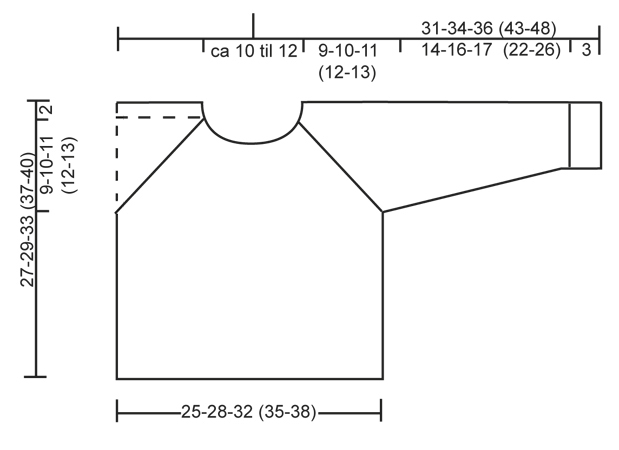
|
|
Dokončili jste tento model?Pak označte své fotky tagem #dropspattern #williamsweater nebo je pošlete do galerie #dropsfan. Potřebujete s tímto návodem poradit?Otevřete-li si návod na stránce garnstudio.com, najdete tam 22 výukových video-ukázek, Komentáře/Dotazy a další užitečné informace. © 1982-2025 DROPS Design A/S. Vyhrazujeme si veškerá práva. Tento dokument, včetně všech jeho dílčích částí, podléhá autorským právům. Podrobnější komentář k možnostem užití našich návodů najdete dole pod každým návodem na našich stránkách. |








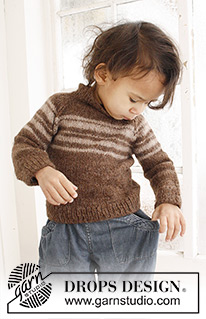
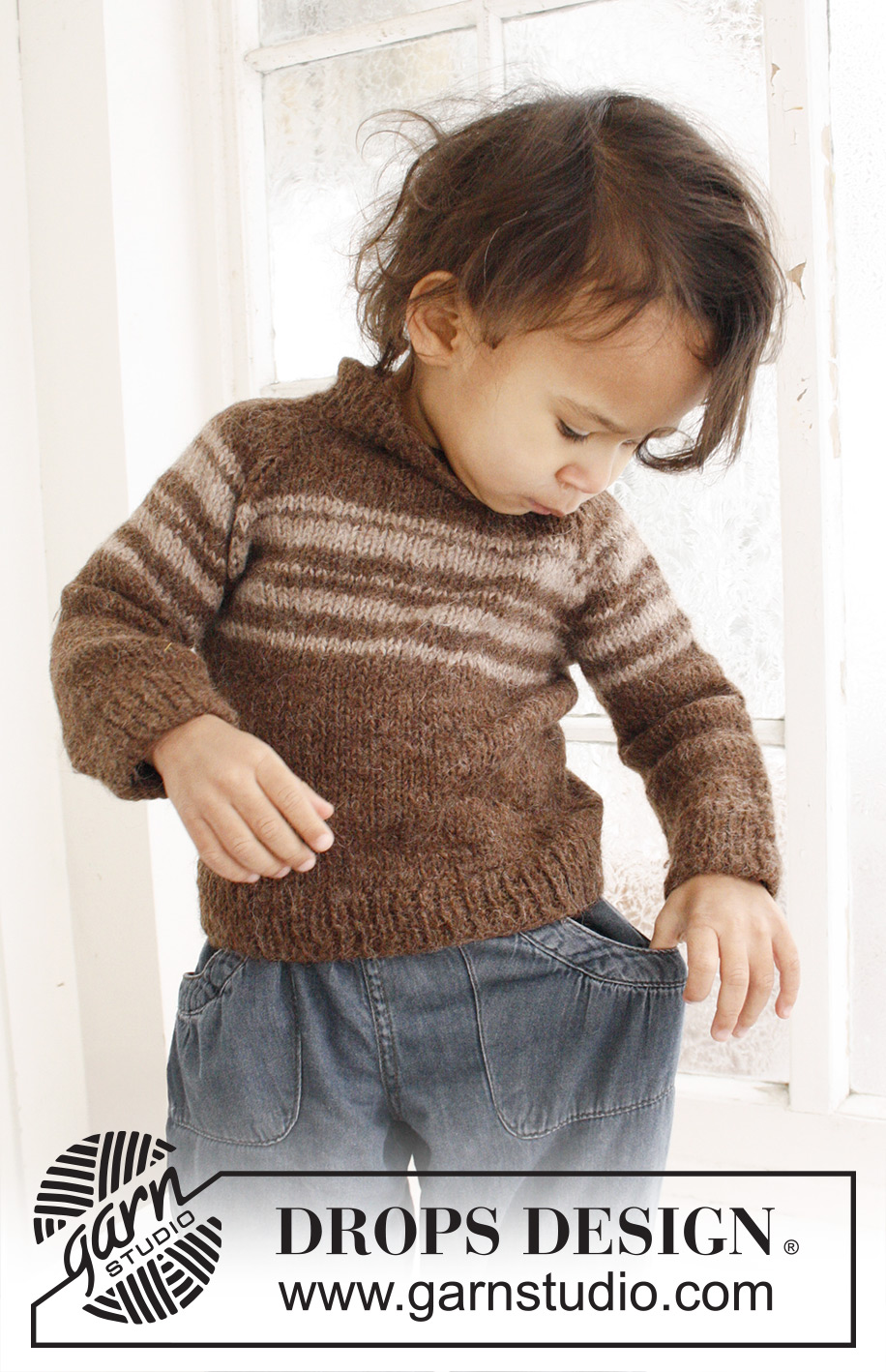


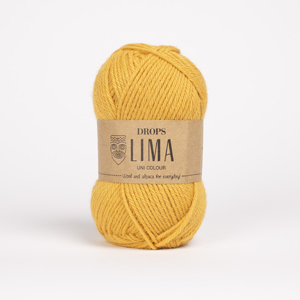
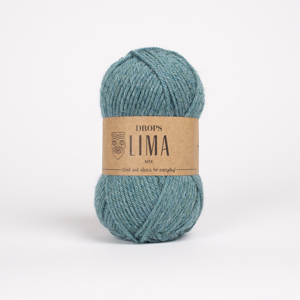
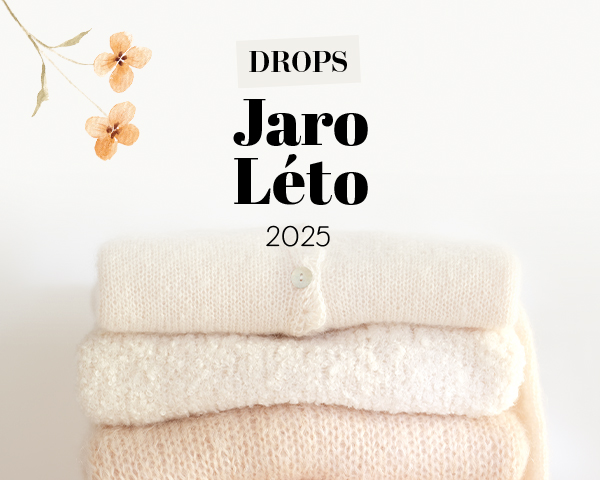
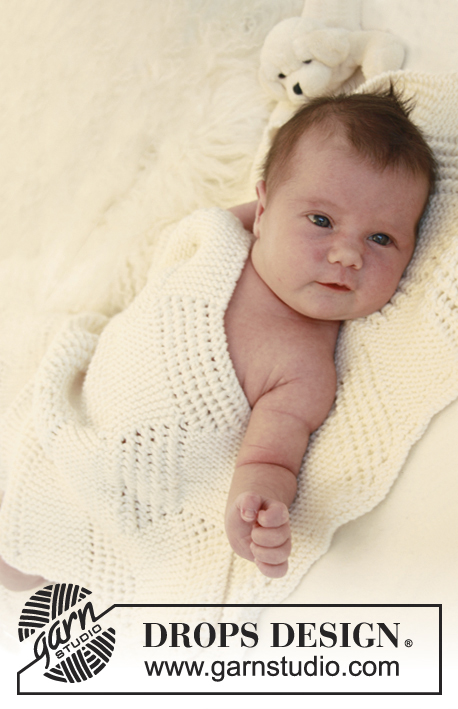






































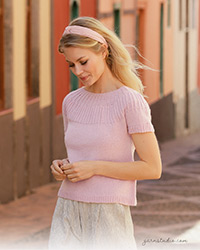
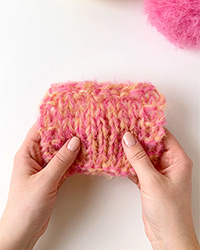
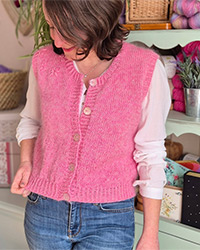
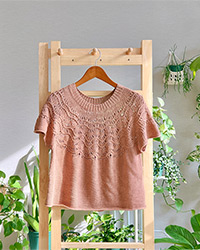
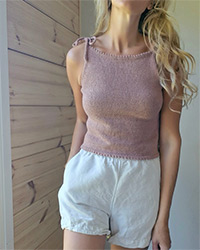

Přidejte komentář k návodu DROPS Baby 21-29
Rádi bychom věděli, co si o tomto modelu myslíte!
Pokud se chcete na něco zeptat, dbejte prosím na to, abyste ve formuláři níže vybrali správnou kategorii - díky tomu se dříve dozvíte, co potřebujete vědět. Povinná pole jsou označena *.